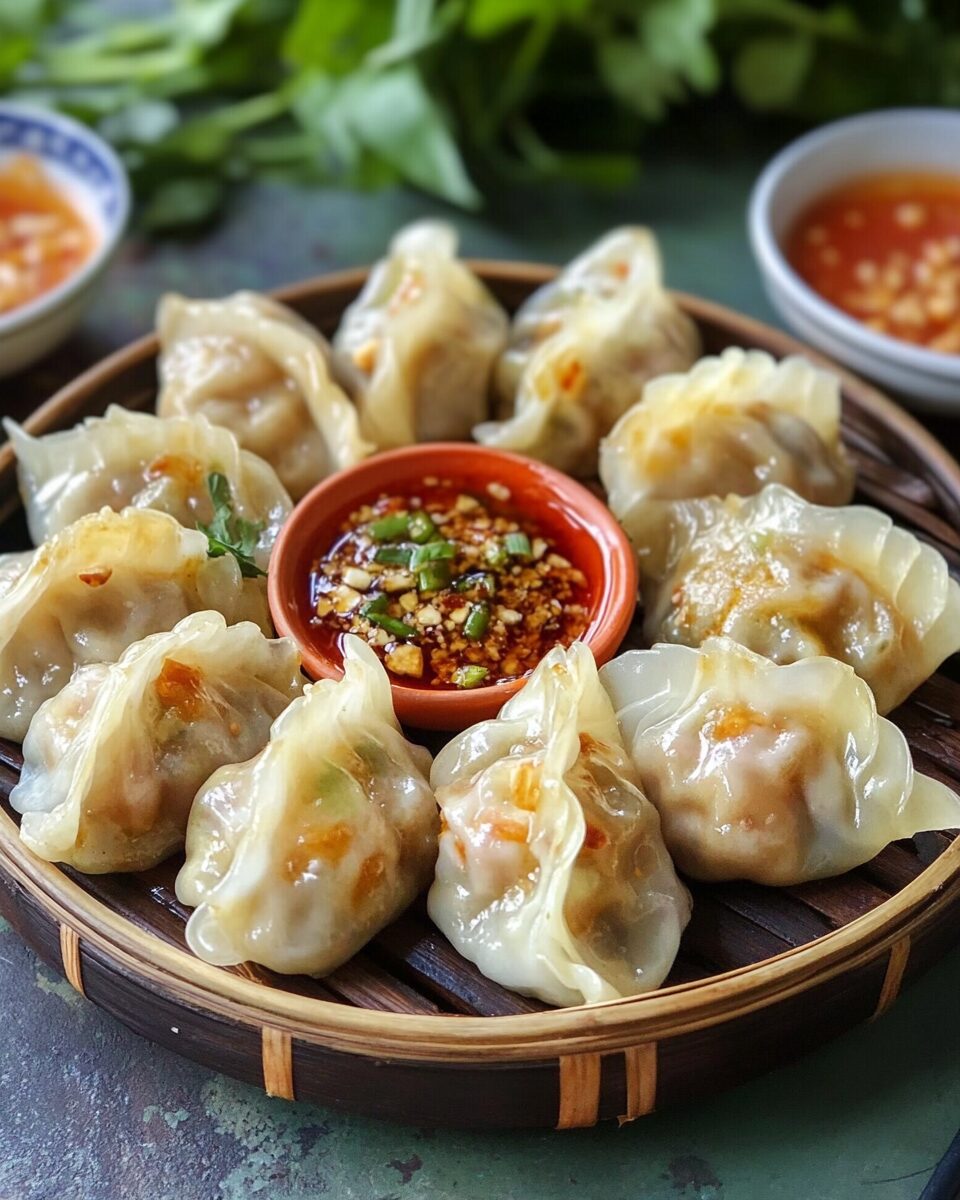These Kanom Jeeb dumplings are a true delight—filled with tender pork, shrimp, and a savory blend of herbs and spices, encased in delicate wrappers. Their juicy and flavorful fillings burst with every bite, making them an irresistible snack or appetizer.
Whether enjoyed as a casual snack or served at a dinner party, these dumplings are sure to impress. The light and tender wrappers perfectly complement the savory filling, and the steaming process ensures that each dumpling stays juicy and tender. Garnished with fresh cilantro, this dish is as visually appealing as it is delicious, giving you a taste of authentic Thai street food right in your own kitchen.
Full Recipe:
- 200g ground pork
- 100g shrimp, peeled and finely chopped
- 1/4 cup water chestnuts, chopped
- 1/4 cup shiitake mushrooms, finely chopped
- 2 tablespoons oyster sauce
- 1 tablespoon fish sauce
- 1 tablespoon sugar
- 2 teaspoons sesame oil
- 1 teaspoon white pepper
- 1 tablespoon garlic, minced
- 20-25 dumpling wrappers (thin flour wrappers)
- A pinch of salt
- 1/4 cup cilantro, chopped (for garnish)
Directions:
- In a mixing bowl, combine the ground pork, chopped shrimp, water chestnuts, shiitake mushrooms, garlic, oyster sauce, fish sauce, sesame oil, sugar, salt, and white pepper. Mix until well-combined.
- Take a dumpling wrapper and spoon about a tablespoon of the filling in the center. Fold the wrapper over and pinch the edges together to seal. Make pleats along the edges to ensure a secure seal.
- Steam the dumplings in a bamboo steamer lined with parchment paper or cabbage leaves for 10-12 minutes, until they are fully cooked and the filling is firm.
- Garnish with freshly chopped cilantro before serving.
Prep Time: 20 minutes | Cooking Time: 12 minutes | Total Time: 32 minutes
Kcal: 180 kcal per serving | Servings: 4 servings
Introduction to Kanom Jeeb (Thai Dumplings)
Kanom Jeeb, a delicious variation of the well-known Chinese pork siu mai, is one of Thailand’s most beloved dumpling recipes. Known for its pleated appearance and savory fillings, Kanom Jeeb has become a staple in Thai cuisine, especially served as appetizers in Thai restaurants or on dim sum carts. These steamed Thai dumplings, often filled with minced pork, shrimp, and aromatic herbs, are not only a treat for the taste buds but are also visually striking. The name “Kanom Jeeb” literally translates to “pleated snack” in Thai, referencing the distinct folded look of the dumpling wrappers. This Thai dish offers a unique blend of flavors and textures that has captivated food lovers worldwide.
A Deep Dive into the Flavors and Ingredients of Kanom Jeeb
The filling of Kanom Jeeb is typically made with a mix of pork and shrimp, both seasoned with flavorful ingredients such as garlic, black peppercorns, coriander root, and sesame oil. These ingredients come together to create a filling that is tender, juicy, and savory. The pork provides a rich, meaty texture while the shrimp adds a slight sweetness, perfectly complementing the spices used in the mix. Other vegetables, such as carrots and shiitake mushrooms, are often included to give the dumplings added texture and depth of flavor. Coriander root, in particular, plays a key role in enhancing the overall freshness and aroma of the dumplings.
The thin, delicate wrappers used for these dumplings are typically made from wonton sheets, which are perfect for steaming. When steamed, the wrappers become soft and translucent, revealing the tantalizing filling inside. While they are traditionally steamed, you can also experiment by boiling, pan-frying, or deep-frying the dumplings to achieve different textures. Each method gives the dumplings a unique twist, whether you want a crispy edge or a soft, melt-in-your-mouth experience.
How to Serve Kanom Jeeb
Kanom Jeeb is incredibly versatile and can be served in a variety of settings. Whether you’re hosting a dinner party, having a casual meal, or craving a snack, these dumplings make an excellent choice. They are often served as part of a larger Thai meal, accompanying dishes like Pad Thai, green curry, or fried rice. They are also a great starter for any Thai meal, preparing the palate for the bolder flavors that follow.
The key to fully enjoying Kanom Jeeb lies in the dipping sauce. A flavorful dipping sauce is essential to complement the savory filling of the dumplings. Traditional sauces include soy-based dipping sauces, Thai sweet chili sauce, or a homemade wonton dipping sauce. These sauces add another layer of flavor that enhances the overall eating experience. You can even get creative by adding a touch of lime juice or chili for an extra kick.
Variations and Customization of Kanom Jeeb
One of the most appealing aspects of Kanom Jeeb is its versatility. While the traditional filling uses pork and shrimp, you can easily customize the dumplings to suit your personal taste. If you’re not a fan of shrimp, simply stick with pork, or substitute it with chicken, beef, or even a vegetarian option with a mix of vegetables. Vegetables such as shredded cabbage, spinach, and bean sprouts can be included in the filling to add a lighter, crunchier texture. For those who enjoy bold flavors, adding a little extra garlic, coriander, or even Thai chilies can bring a zesty twist to the dumplings.
The dumpling wrappers themselves are also quite adaptable. In Thailand, fresh wrappers are available, but outside of Asia, you’ll likely find frozen ones in Asian grocery stores. These wrappers are made from a simple dough, making them easy to fold and mold around the dumpling filling. It’s important to choose the right wrapper for the cooking method—thick wrappers for deep-frying and thinner ones for steaming.
Perfecting the Dumpling Wrapping Technique
Wrapping the dumplings can be a bit tricky for beginners, but with a little practice, it becomes second nature. The key is to create a small pocket in the center of the wrapper, spoon in the filling, and then carefully fold and seal the wrapper around it. The pleating technique, where you fold the edges of the wrapper into small folds, ensures that the dumpling remains sealed during cooking. If you’re finding it difficult to wrap the dumplings by hand, consider using a small spoon or dumpling mold to shape the dumplings uniformly.
Once wrapped, the dumplings are steamed in a bamboo steamer, which is the traditional method. Steaming gives them their signature tender texture and allows the flavors to meld together. It’s important to line the steamer basket with parchment paper or cabbage leaves to prevent the dumplings from sticking.
How to Store and Reheat Kanom Jeeb
Kanom Jeeb is a great dish to make in advance, as they store and reheat quite well. After cooking the dumplings, allow them to cool completely before storing them in an airtight container in the refrigerator. They can be stored for up to two days. If you have leftovers, you can freeze the dumplings before steaming. Lay them out on a tray to freeze individually, and then store them in a freezer bag. When ready to eat, simply steam the frozen dumplings until they are heated through—no need to thaw beforehand. Alternatively, you can also pan-fry or deep-fry them for a crispy texture.
Health Considerations and Nutritional Value
Kanom Jeeb is a relatively light dish compared to many other deep-fried snacks. While the dumpling wrappers do contain some carbohydrates, the fillings themselves are packed with protein and vegetables, making them a nutritious choice. The pork and shrimp provide essential amino acids, while the addition of mushrooms and vegetables adds fiber and vitamins. By choosing lean cuts of meat and using minimal oil during the cooking process, Kanom Jeeb can be a healthy appetizer or snack option.
However, for those with dietary restrictions, it’s important to note that traditional dumpling wrappers are made from wheat flour and are not gluten-free. To make a gluten-free version, you can substitute the wrappers with those made from rice flour or tapioca starch. Additionally, adjusting the filling to suit your tastes is easy, whether you choose to go for a vegetarian version or reduce the fat content by opting for lean meats.
Conclusion
Kanom Jeeb is a versatile and delicious Thai dumpling that can easily become a favorite in your recipe collection. Whether you enjoy it as a snack, appetizer, or as part of a full Thai meal, its rich flavors and delicate texture make it a memorable dish. The recipe is simple, yet packed with flavor, offering endless opportunities for customization. By experimenting with different fillings, sauces, and cooking methods, you can create a variety of variations that suit your preferences. With its combination of savory pork, shrimp, and fresh vegetables, Kanom Jeeb is sure to become a household favorite.






